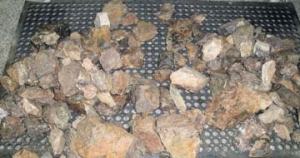NOAA Teacher at Sea
Roy Moffitt
Aboard USCGC Healy
August 7 – 25, 2018
Mission: Healy 1801 – Arctic Distributed Biological Observatory
Geographic Area: Arctic Ocean (Bering Sea, Chukchi Sea, Beaufort Sea)
Date: August 14-15, 2018
Current location/conditions:
Evening August 15 – North- Northwest of Wainwright, Alaska
Air temp 35F, sea depth 47m , surface sea water temp 32.2F
Life on a LEGO
The LEGO is a nickname given to the large green plastic pallet-like mooring. Their retrieval from the sea floor is pictured here. This equipment was retrieved after being deployed for a year on the sea floor in about 40 meters of water. The mooring is called a DAFT (Direction Acoustic Fish Tracker). On the DAFT there are instruments that measure ocean temperature, salinity, and pressure. The primary instrument is an echo sounder that records any schools of fish that may pass overhead.

What the DAFT was not designed to do, but does well, is catch sea life. The fiberglass pallet has 1 1/2″ square holes in it that allow water to pass through on retrieval and it also catches sea life as if it were a net. Yesterday we pulled two of these “Legos” from the sea and they were covered with marine life. The most remarkable sight were the large blue king crabs, (around half dozen on one pallet). Here I am holding one of the bigger ones– such awesome looking creatures!

On the smaller size, we found a hermit crab (shown here hiding in a shell).

Also on board were many sea stars. Most were the Brittle Stars. This is the picture of the sea star with the small legs. I think they are called the Brittle Stars because when I tried to gently remove them from the mooring, sadly their legs kept breaking off. There were dozens of these on the mooring.

There was another sea star with nine legs. It was very pretty and looks like a drawing of the sun. Not surprising, I found out this one is called the “Sun Star.”
Some not-so-pretty items on the moorings I like to call “mooring acne” are called tunicates. These are filter feeders and come in many different forms.
The one on my hand looks like a giant pimple and when you try to take it off the mooring it squirts you in the face. Not surprisingly this tunicate is called the “Sea Squirt.”
Think about it…
All of the life on the Lego mooring was sent back to the sea to hopefully find a new home. The Lego pallet mooring mentioned above is not large, about 4 ft by 6ft. The mooring in this story was only in the ocean one year and became the home of the above mentioned marine animals – crabs, sea stars, tunicates, and also thousands of barnacles! One tiny piece of the sea floor contained all this life! Imagine how rich in life the entire unseen ecosystem is in the Chukchi Sea!
Today’s Wildlife Sightings
For the last two days, I saw several walruses. Pictured below is one that popped up by a piece of ice. Teaser – look for a future blog focusing on walrus and their habitat.

Now and Looking forward
We are now seeing small bands of pack ice and individual pieces of ice called “growlers”. Sea ice has not interrupted science operations, as of today. There is plenty of open water so far. We should see ice of different concentrations for the rest of the trip as we continue to head north. Look for future pictures and some of the science on sea ice coming soon. For now here are a couple pictures from August 15.












































